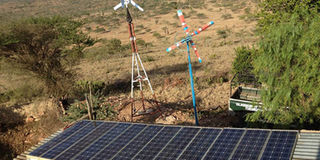Firm sets out to light up rural homes in Nyanza with renewable electricity

PHOTO | EVERLINE OKEWO Micro wind turbines on Remba Island in Homa Bay County.
What you need to know:
- Initial connection fee is Sh3,000 for those using the PAYG technology
- The model relies on a third party to finance the up-front cost of the grid
A firm has set out to light homes in the remote parts of Nyanza Province using renewable energy. Started three years ago, PowerGen said it would harness a remotely controlled micro-grid to convert wind and solar energy into electricity.
Remba Island in Homa Bay County, which hosts over 8,000 people depending solely on fishing as their source of livelihood, is one of the areas that will be a beneficiary of this project.
Poor infrastructure and limited access to clean energy, safe water, and health services have been a major stumbling block to the economic growth and development of this unique island.
Mr Ken Orido, a fisherman on the island, said lack of access to power occasioned by the high cost of installation has forced the inhabitants to contend with environment-damaging sources like kerosene, firewood, charcoal, unreliable diesel generators, and disposable batteries.
“Kenya’s electricity power mix is among the most sustainable in the world with 80 per cent of electricity coming from renewable sources,” said Ms Eve Meyer, director of business operations at PowerGen.
She said much of the available alternative sources of energy have not been fully exploited. “Only 18 per cent of the total population is served with power from the main grid, which means 30,000 million people have to cope with other environmental-damaging fuels,” said Ms Meyer.
PAY FOR POWER YOU CONSUME
The team has made it easier for residents to use a technology called Pay-as-you-go (PAYG) through which one can only buy units of power via mobile phones so that you only pay for the power that you consume.
The initial connection fee is Sh3,000 for those using the PAYG technology. This can be done in small prepaid amounts depending on one’s means. “When credit for energy runs out the power turns off, just like a cell phone,” said Ms Meyer.
Micro-grids take advantage of new mobile-enabled metering technology that records how much each house is consuming and can limit the power going to each connection based on the amount of energy credit each consumer has in their account.
The mobile-enabled micro-grids offer a simple way of providing renewable power in regions that are in need at a price-point that individual consumers can afford. Wind energy, she said, is a cost-effective, eco-friendly, and robust source of power for off-grid areas.
PowerGen has managed to connect over 100 rural homes with wind and solar energy in different parts of the country.
With an initial capital of Sh1.5 million, the team’s of experts have been able to provide clients with power generation systems, batteries, inverters and controllers, wiring, the metering technology, and distribution of power lines.
The model relies on a third party to finance the up-front cost of the grid. This is mostly applicable to organisations and institutions which plan to help rural residents get access to electricity.
“Many Kenyans lack access to the national electricity grid which makes them eager for solutions to bring power to their villages and communities,” said Ms Meyer.
In these micro-grids, a central solar and wind hybrid system is installed to generate enough power for residents of a particular area.
The power is then distributed to homes and businesses that wish to be connected, much like in a traditional electricity grid.
Revenue from such power can be shared with local stakeholders in the community who oversee the daily operation of the power system and are responsible for customer service and signing up new connections.





